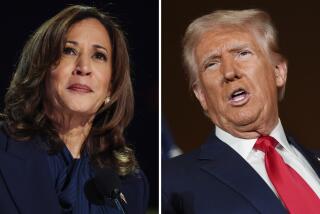The Rich Don’t Need a Tax Cut
- Share via
When President Clinton vetoed the 1995 budget bill, the legislation incorporating the “contract with America,” he gave the following assessment of its tax provisions:
“[The bill would] provide a huge tax cut whose benefits would flow disproportionately to those who are already the most well-off.
“Moreover,” he wrote in his veto message, “this bill creates new fiscal pressures. Revenue losses from the tax cuts grow rapidly after 2002, with costs exploding for provisions that primarily benefit upper-income taxpayers. Taken together, the revenue losses for the three years after 2002 for the individual retirement account, capital gains and estate tax provisions exceed the losses for the preceding six years.”
The current House and Senate tax bills provide tax cuts at least as large and tilted at least as disproportionately to the most well-off as did the tax cuts in the 1995 bill. In addition, the cost of the upper-income tax cuts in the new tax bills would grow more rapidly as the years go by. Will the President veto the tax bill Congress sends to him this year?
According to a Treasury Department analysis released in 1995, the wealthiest one-fifth of households would have received 63% of the benefits under the 1995 budget legislation when the tax cuts were phased in fully.
Under this year’s Senate bill, the top one-fifth of households would receive 65% of the tax cuts when the cuts are phased in fully. Under the House bill, the top one-fifth would receive 67%. (The Treasury Department used the same methodology for assessing the current bills and the ’95 bill, methodology that also was used by the Reagan and Bush administrations.) Under both the current bills and the 1995 bill, about one-third of the tax cut benefits would go to the wealthiest 5% of households. And the dollar value of the current legislation’s tax cuts for high-income households are on average as large or larger than those proposed in 1995.
These findings, which also apply to the proposal offered by congressional negotiators to the president, may seem surprising. News accounts of the current tax bills often focus on the $85-billion net revenue loss that would occur between 1997 and 2002. The 1995 legislation would have produced a net revenue loss of $195 billion over a comparable time period, suggesting that the current bills are substantially smaller.
But the initial costs of the current bills are misleading. The high-income tax cuts in the current bills ultimately grow to about the same size as those in the vetoed 1995 budget. In fact, the individual retirement account expansions and estate tax cuts in the current bills, both of which are designed to heavily benefit households at high income levels, are more generous than those proposed in 1995.
Rather than reduce the size of the upper-income tax cuts, Republican leaders chose to delay their full implementation beyond 2002. The extent to which the tax cuts for high-income households are “backloaded” is more dramatic than under the 1995 bill. In vetoing the 1995 legislation, President Clinton observed that the revenue losses during the three years after 2002 for IRAs, capital gains and estate tax provisions would exceed the losses for the preceding six years. Under the new bills, the costs of these provisions in 2007 alone exceed their costs in the first six years combined. Furthermore, the tax cut provisions benefiting high income households would still be growing at an explosive rate after 2007.
The president has introduced his own tax proposal, one much more targeted toward the middle class. In addition, its costs would not grow explosively in the future, placing less of a drain on the Treasury in the years when the baby boom generation retires and deficits are expected to reemerge and climb to dangerous levels.
Negotiations on the final contours of the tax bill are now taking place. Will the president fight hard for his proposal, or will he accept a congressional approach that, with good reason, he vetoed before?
More to Read
Get the L.A. Times Politics newsletter
Deeply reported insights into legislation, politics and policy from Sacramento, Washington and beyond. In your inbox twice per week.
You may occasionally receive promotional content from the Los Angeles Times.







